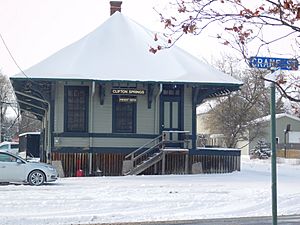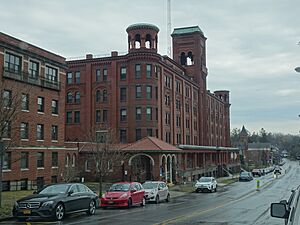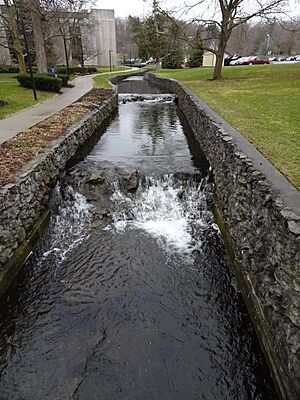Clifton Springs, New York facts for kids
Quick facts for kids
Clifton Springs, New York
|
|
|---|---|
|
Village
|
|

The former New York Central Railroad freight station in Clifton Springs
|
|
| Country | United States |
| State | New York |
| County | Ontario |
| Area | |
| • Total | 1.48 sq mi (3.84 km2) |
| • Land | 1.48 sq mi (3.84 km2) |
| • Water | 0.00 sq mi (0.00 km2) |
| Elevation | 577 ft (176 m) |
| Population
(2020)
|
|
| • Total | 2,209 |
| • Density | 1,490.55/sq mi (575.31/km2) |
| Time zone | UTC-5 (Eastern (EST)) |
| • Summer (DST) | UTC-4 (EDT) |
| ZIP code |
14432
|
| Area code(s) | 315 and 680 |
| FIPS code | 36-16375 |
| GNIS feature ID | 0970014 |
| Website | [1] |
Clifton Springs is a village located in Ontario County, New York, United States. The population was 2,127 at the 2010 census. The village takes its name from local mineral springs.
The Village of Clifton Springs is located primarily in the Town of Manchester, but the eastern part is in the Town of Phelps. The village is southeast of Rochester, NY.
- (The area and population reported and analyzed in this article are also reflected in the aggregate values reported for the town as a whole. See: Manchester (town), New York.)
Contents
History
The location was first settled around 1801, and much of the early community endeavors exploited the sulfur springs as a health spa. The village was incorporated in 1859.
The development of the area was slow until 1849, when Dr. Henry Foster came looking for a place to begin his water cure. Modern medicine was in its early stages, and it was thought that the sulphur waters together with a strong religious revival could restore many to active and useful lives. Sulphur Springs, as it was once called, was well known throughout the eastern part of the US because of this. Over the years, thousands of people came to enjoy the benefits of the water and rest and regain their health. Some famous people who visited the area were Elvis Presley, and Bette Davis' daughter. The area around the former sanitarium was designated the Clifton Springs Sanitarium Historic District and listed on the National Register of Historic Places in 1990.
In March 1917, a local convalescent and architect George Edward Barton assembled a small group of authorities from around the country to discuss the benefits of the "work cure", or the value of activity in promoting recovery. During that meeting, the profession of occupational therapy was born with the incorporation of what is now The American Occupational Therapy Association. In 1968, a plaque was placed on Barton's home, known as Consolation House, to commemorate the 50th anniversary of the profession. Between 1915 and 1921, Barton maintained Consolation House as a convalescent home employing therapeutic activity.
Today, there has been a revival of interest in bathing at mineral springs. The Clifton Springs Hospital & Clinic has devoted an entire wing to this treatment.
Modern-day Clifton Springs offers an excellent school system, modern hospital, YMCA, Chamber of Commerce, Rotary Club and numerous other organizations, country club/golf course, national bank, library, senior citizen community, volunteer fire department, a park area, tennis courts, a skate park, shaded streets, a large manufacturing firm, and an active business section. In the summer months, the town participates in a business program dubbed "Super Sundays."
The Phelps-Clifton Springs Central School District serves the students who live in Clifton Springs. The school district, also known as Midlakes, serves the students of the area. The current Superintendent is Matt Stickles.
The Oliver Warner Farmstead was listed on the National Register of Historic Places in 1988.
Geography
Clifton Springs is located at 42°57′44″N 77°8′15″W / 42.96222°N 77.13750°W (42.962310, -77.137362).
According to the United States Census Bureau, the village has a total area of 1.4 square miles (3.6 km2), all land.
Clifton Springs is immediately south of both the New York State Thruway (Interstate 90) and New York State Route 96. County Road 13 passes through the village as Main Street.
Demographics
| Historical population | |||
|---|---|---|---|
| Census | Pop. | %± | |
| 1870 | 746 | — | |
| 1880 | 902 | 20.9% | |
| 1890 | 1,297 | 43.8% | |
| 1900 | 1,617 | 24.7% | |
| 1910 | 1,600 | −1.1% | |
| 1920 | 1,628 | 1.8% | |
| 1930 | 1,819 | 11.7% | |
| 1940 | 1,413 | −22.3% | |
| 1950 | 1,838 | 30.1% | |
| 1960 | 1,953 | 6.3% | |
| 1970 | 2,058 | 5.4% | |
| 1980 | 2,039 | −0.9% | |
| 1990 | 2,175 | 6.7% | |
| 2000 | 2,223 | 2.2% | |
| 2010 | 2,127 | −4.3% | |
| 2020 | 2,209 | 3.9% | |
| U.S. Decennial Census | |||
As of the census of 2000, there were 2,223 people, 869 households, and 530 families residing in the village. The population density was 1,541.4 inhabitants per square mile (595.1/km2). There were 921 housing units at an average density of 638.6 per square mile (246.6/km2). The racial makeup of the village was 97.57% White, 1.21% African American, 0.13% Native American, 0.18% Asian, 0.22% from other races, and 0.67% from two or more races. Hispanic or Latino people of any race were 0.81% of the population.
There were 869 households, out of which 31.3% had children under the age of 18 living with them, 45.3% were married couples living together, 12.2% had a female householder with no husband present, and 38.9% were non-families. 34.3% of all households were made up of individuals, and 20.6% had someone living alone who was 65 years of age or older. The average household size was 2.33 and the average family size was 3.02.
In the village, the population was spread out, with 23.6% under the age of 18, 6.5% from 18 to 24, 27.6% from 25 to 44, 21.9% from 45 to 64, and 20.4% who were 65 years of age or older. The median age was 40 years. For every 100 females, there were 85.3 males. For every 100 females age 18 and over, there were 79.9 males.
The median income for a household in the village was $36,595, and the median income for a family was $49,485. Males had a median income of $33,929 versus $24,250 for females. The per capita income for the village was $17,238. About 8.0% of families and 13.1% of the population were below the poverty line, including 15.7% of those under age 18 and 9.0% of those age 65 or over.
See also
 In Spanish: Clifton Springs (Nueva York) para niños
In Spanish: Clifton Springs (Nueva York) para niños




